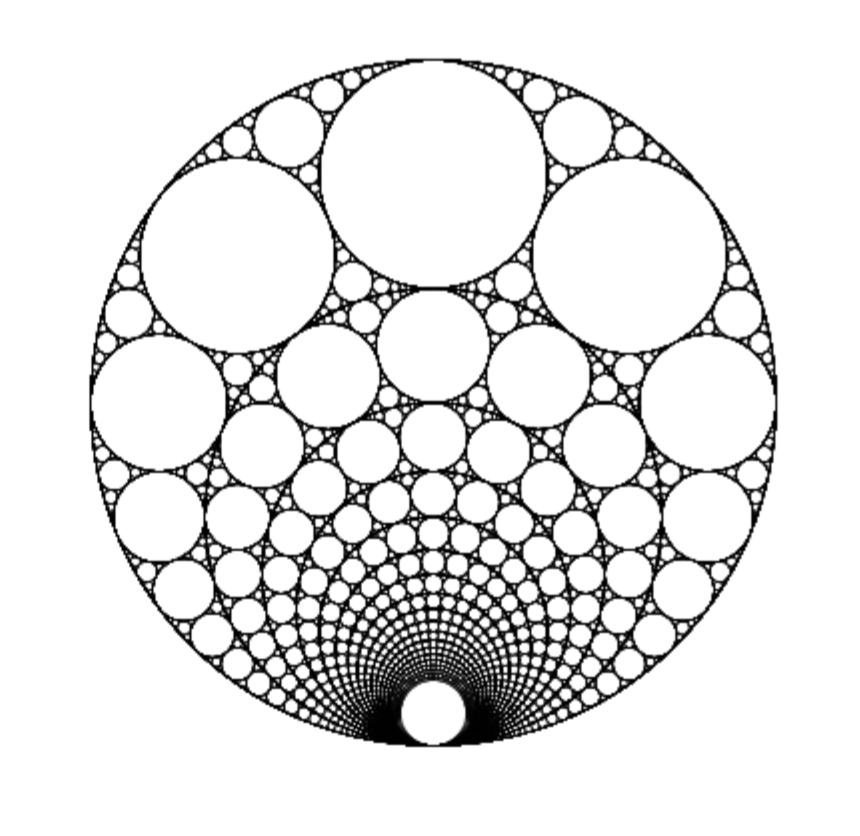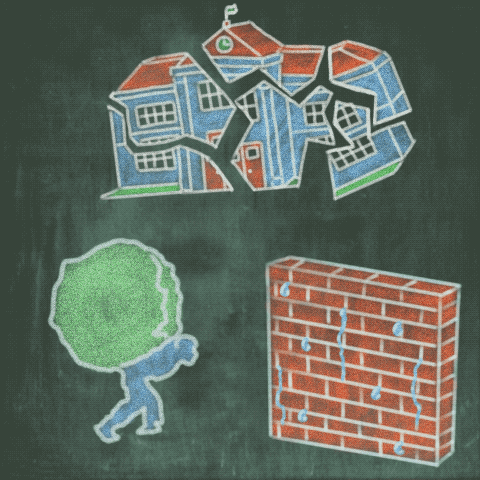The Professionall Logo: A Symbol of the Education Profession
Published 30 July 2024
A Symbol of the Education Profession
At first glance, our logo is simply made of three concentric crescents, but when looked at with a keener eye, a more complex image comes to light. Our culture starts with our logo––a symbol of the education profession with endless interpretations.
Take a moment to reflect on our logo. What do you see? What does it evoke? Share your ideas in the comments below.
A breakthrough in the design of the company came when I found the onion model (Wikipedia), specifically made of three concentric circles, each with a radius one unit longer than the previous circle, and all three circles sharing a singular tangent.
Though the model isn’t uncommon, there is no accepted name to specify this exact symbol, as some onion models are represented as a target or bull’s-eye, not having a tangent shared among three circles. Therefore, I’ll refer to this arrangement as the tangential onion model, as the three circles sharing a single tangent point symbolically represents a unifying goal shared among each of the groups.
Both the onion model and the tangential variety have been used in many contexts, like psychology and computing, to represent complex information structures (Wikipedia). Similar to a Venn diagram, the tangential onion model is technically a Euler diagram, which shows important and complex relationships between sets (Wikipedia).
This design can be seen in mathematics (see Chaitanya's Random Pages, 2014; Hornbeck, 2013), in geometry, like the Problem of Apollonius and his nested gaskets (Stedl, 2008), and in science, like 2D representations of the doppler effect (Harrison, 2022) or Smith Charts used by electrical engineers (ETHW, 2018).
More pertinent to our application, this design is used in knowledge management, where four circles represent data, information, knowledge, and wisdom, as these concepts lead to and compound upon one another (Igonor, 2002).
In education, this design has represented knowledge-of-self, knowledge-of-practice and in-practice, and knowledge-for-practice (Gairín-Sallán & Rodrígues-Gómez, 2009), different levels of community systems like Bronfenbrenner’s Ecological Theory (Chu, Liu, & Fang, 2021; Stanger, 2011), the expansion past one’s comfort zone (Ambach, 2021), creating sustainable change (Enaohwo, 2020; Fraser, 2013), and the needs of Bloom’s taxonomy (Deepak, 2017). Needless to say, the tangential onion model is rich with interpretations and applications.
The tangential onion model was critical to my framing of the markets within the education profession, wherein: (1) the innermost circle represents teachers and other individuals; (2) the middle circle represents administrators of organizations and institutions who lead teachers and are often teachers or ex-teachers themselves; and (3) the outermost circle represents all the entities that provide professional development to the previous two groups, such as teacher educators, researchers, publishers, curriculum developers, and more, who, too, are often teachers and/or administrators themselves.
The tangential onion model was also influential when I began my research to codify the challenges facing the education profession, wherein: (1) the innermost circle represents problems that impact or are caused by teachers or professionals on an individual level; (2) the middle circle represents problems that impact or are caused by institutions on an organizational level; and (3) the outermost circle represents problems that impact or are caused by the profession as a whole.
Many individuals working in the education profession often work in all three of these circles and are impacted by all three challenge groups at various capacities, but all of these professionals share a common mission, or tangent: education. Thus, the need for the tangential onion model.
Many educators devote their entire careers to working solely within the innermost tier as they find their efforts best spent working directly with students. Some educators find joy in contributing to their school or district, like principals or administrators. Then there are those special professionals who work in all tiers simultaneously or oscillate between them throughout their careers.
These circles can be representative of many other relationships, such as student, teacher, and leader; or classroom, school, and institution framework; or pre-service educators, novice educators, and expert educators; or teacher leader, school leader, and professional leader.
After working with this design for some time, I wanted to integrate its multifaceted implications into the Professionall logo, however I wanted our logo to be representative of these ideas in addition to the ideologies of the education profession as a whole (not to mention be uniquely marketable as a company brand). I played around on different designs for months until I doodled something similar to the final logo. At first, I thought it resembled a rose, but then a succession of epiphanies confirmed I had found our logo.
The first interpretation of our logo is a depiction of a teacher with their back turned, the center circle is their head full of knowledge, the middle circle is their open arms sharing that knowledge, and the outermost circle is a fisheye view of their lecture hall or classroom full of students receiving that knowledge.
The second reading can be interpreted as a teacher facing forward with their arms above their head beckoning the outer ring––the rest of the profession––to unite in our efforts to improve the quality of education. There are several other applicable interpretations, such as the rings being representative of students and teachers with educational support systems enveloping them. We can even consider the negative space between the crescents as representative of the divides between teachers, administrators, and teacher educators, or we can consider the crescents to be incomplete circles, reminding us that work of educators is cyclical yet never complete and that there is always more to learn.
After conferring with trusted friends and colleagues about their thoughts on the potential logo, they all had a similar reaction, “At first, I didn’t see it, but after you pointed it out, I can’t unsee the teacher!” This obscured-to-enlightened storyline––along with the aforementioned guiding and inspiring imagery––evokes exactly what we do as educators; We serve as the nurturing catalyst to alter our students’ perspectives on the world.
Just as the rings of our logo are independent yet interconnected, we hope to facilitate the collaboration of educators, administrators, and teacher educators within a professional information ecosystem built to make the lives of educators easier and the quality of education better. As a public benefit corporation, the specific purpose of Professionall is to advocate for the wellbeing of every educator in the world, to reduce teacher burnout and attrition, and to inspire and nourish the future generations of educators and educational leaders.
Our mission is:
i. to organize and democratize the world’s pedagogical knowledge;
ii. to identify and collectively resolve the deficits within the education profession;
iii. to enhance the relevancy, quality, and outcomes of professional development; and
iv. to implement transparent, sustainable, and equitable community practices for all of the education profession.
After a long journey and many alterations, we landed on a logo that is both evocative of the tangential onion model and that is uniquely representative of the education profession and the mission of this company. Going forward, we will continue to be inspired by what this logo represents and continue to find new inspiration from its design.
Discussion Question
What did you see when you first looked at our logo? Can you think of any other applicable interpretations that weren’t mentioned in the blog? In the comments below, share your thoughts!
Related Posts
-
Ambach, M. (2021). Unwind Rewind 86 The Comfort Zone. Mixcloud. https://www.mixcloud.com/marilyn-ambach/unwind-rewind-86-the-comfort-zone/
Chaitanya's Random Pages. (2014, April 25). Three and four tangent circles. CKRAO. https://ckrao.wordpress.com/2014/04/25/three-and-four-tangent-circles/
Chu, W., Liu, H., & Fang, F. (2021). A tale of three excellent Chinese EFL teachers: Unpacking teacher professional qualities for their sustainable career trajectories from an ecological perspective. Sustainability, 13(12), 6721. https://doi.org/10.3390/su13126721
Deepak, A. (2017, July 15). Buzzwords make an impact paving the way to learn something new, and creating value for and within the profession. ScooNews. https://scoonews.com/news/news-buzzwords-make-an-impact-paving-the-way-to-learn-something-new-and-creating-value-for-and-within-the-profession-1853/
Enaohwo, O. M. (2020, February 21). The definitive guide to organizational change management. Sweet Process. https://www.sweetprocess.com/organizational-change-management/
ETHW. (2018, February 26). Smith Chart. ETHW. https://ethw.org/Smith_Chart
Euler diagram. (2024, July 12). Wikipedia. Retrieved July, 30, 2024, from https://en.wikipedia.org/wiki/Euler_diagram
Fraser, S. (2013, February 13). 9 Change Models. Spread Good Practice. http://spreadgoodpractice.blogspot.com/2013/02/9-change-models.html
Gairín-Sallán, J., & Rodríguez-Gómez, D. (2009). Teacher professional development through knowledge management in educational organisations. In Organizational learning and knowledge: Concepts, methodologies, tools and applications (pp. 1297-1315). IGI Global.
Harrison, D. (2022, May 5). Simulation of the doppler effect in 2D. YouTube. https://www.youtube.com/watch?v=-sSLcD6bVkM
Hornbeck, D. (2013, November 24). Write-up 11: Polar Rose Curves. jwilson.coe.uga.edu. http://jwilson.coe.uga.edu/EMAT6680Fa2013/Hornbeck/Write-up%2011.pdf
Igonor, A. (2002). Success factors for development of knowledge management: In e-learning in gulf region institutions. Journal of Knowledge Management Practice. http://www.tlainc.com/articl37.htm
Onion Model. (2024, February 18). Wikipedia. Retrieved July, 30, 2024, from https://en.wikipedia.org/wiki/Onion_model
Stanger, N. (2011). Moving “eco” back into socio-ecological models: A proposal to reorient ecological literacy into human developmental models and school systems. Human Ecology Review, 18, 167-173. https://www.researchgate.net/figure/An-adapted-illustrated-model-of-a-Bronfenbrenners-Ecological-Theory-Adapted-from_fig1_285232380
Stedl, T. (2008, February 28). File:ApollianGasketNested 2-20.svg. Wikimedia Commons. https://commons.wikimedia.org/wiki/File:ApollianGasketNested_2-20.svg







